Remote Sensing of Antarctic Glacier and Ice-Shelf Front Dynamics—A Review
Abstract
1. Introduction: Relevance of Antarctica and Scope of this Review
- How can calving front dynamics be measured based on remote sensing imagery?
- How good is the circum-Antarctic data availability of glacier and ice-shelf front positions?
- What circum-Antarctic patterns of retreating and advancing fronts can be observed?
2. The Importance of Calving Front Dynamics
3. Review on the Remote Sensing of Calving Fronts
3.1. Remote Sensing of Calving Fronts with Optical and SAR Sensors and Applied Sensors
3.2. Methods to Extract Calving Fronts from Satellite Imagery
3.2.1. Semi-Automatic Approaches
3.2.2. Automatic Approaches
3.3. Methods to Measure Calving Front Dynamics
3.4. Categorization of Calving Front Studies
3.5. Geospatial Agglomeration and Coverage of Calving Front Studies
- Local case studies
- Regional studies
- Circum-Antarctic coastline studies
3.5.1. Local Calving Front Studies
3.5.2. Regional Calving Front Studies
3.5.3. Circum-Antarctic Coastline Studies
3.6. Temporal Availability of CFL Measurements
3.7. Circum-Antarctic Calving Front Change Rates
4. The Future Potential of Earth Observation to Analyze CFLs
4.1. Need for Homogenized Data
4.2. Need for Longer, More Frequent, and Spatially Complete Measurements
4.3. Sensor Requirements
4.4. Need for Joint Data Analysis
5. Conclusions
Supplementary Materials
Author Contributions
Funding
Acknowledgments
Conflicts of Interest
References
- Swithinbank, C.; Chinn, T.J.; Williams, R.S.; Ferrigno, J.G. Satellite Image Atlas of Glaciers of the World: Antarctica; U.S. Geological Survey Professional Paper 1386-B; United States Government Printing Office: Washington, DC, USA, 1988. [Google Scholar]
- Fox, A.J.; Cooper, R. Measured properties of the Antarctic ice sheet derived from the SCAR Antarctic digital database. Polar Record 1994, 30, 201–206. [Google Scholar] [CrossRef]
- Vaughan, D.G.; Comiso, J.C.; Allison, I.; Carrasco, J.; Kaser, G.; Kwok, R.; Mote, P.; Murray, T.; Paul, F.; Ren, J.; et al. Observations: Cryosphere. Clim. Chang. 2013, 2103, 317–382. [Google Scholar]
- IMBIE. Mass balance of the Antarctic Ice Sheet from 1992 to 2017. Nature 2018, 558, 219–222. [Google Scholar] [CrossRef] [PubMed]
- Liu, H.; Jezek, K.C. Automated extraction of coastline from satellite imagery by integrating Canny edge detection and locally adaptive thresholding methods. Int. J. Remote Sens. 2004, 25, 937–958. [Google Scholar] [CrossRef]
- Rignot, E.; Jacobs, S.; Mouginot, J.; Scheuchl, B. Ice-shelf melting around Antarctica. Science 2013, 341, 266–270. [Google Scholar] [CrossRef] [PubMed]
- Radić, V.; Bliss, A.; Beedlow, A.C.; Hock, R.; Miles, E.; Cogley, J.G. Regional and global projections of twenty-first century glacier mass changes in response to climate scenarios from global climate models. Clim. Dyn. 2014, 42, 37–58. [Google Scholar] [CrossRef]
- Rose, G.; McElroy, C.T. Coal Potential of Antarctica; Australia Bureau of Mineral Resources, Geology and Geophysics; Australian Government Publishing Service: Canberra, Australia, 1987.
- Wright, N.A.; Williams, P.L. Mineral Resources of Antarctica; United States Department of the Interior: Washington, DC, USA, 1974. [Google Scholar]
- Naylor, S.; Siegert, M.; Dean, K.; Turchetti, S. Science, geopolitics and the governance of Antarctica. Nat. Geosci. 2008, 1, 143–143. [Google Scholar] [CrossRef]
- Secretariat of the Antarctic Treaty. Compilation of Key Documents of the Antarctic Treaty System, 3rd ed.; Secretariat of the Antarctic Treaty: Buenos Aires, Argentina, 2017; Volume 3. [Google Scholar]
- Swithinbank, C. Airborne tourism in the Antarctic. Polar Record 1993, 29, 103–110. [Google Scholar] [CrossRef]
- Dodds, K. Governing Antarctica: Contemporary Challenges and the Enduring Legacy of the 1959 Antarctic Treaty. Glob. Policy 2010, 1, 108–115. [Google Scholar] [CrossRef]
- Bindoff, N.L.; Stott, P.A.; AchutaRao, K.M.; Allen, M.R.; Gillett, N.; Gutzler, D.; Hansingo, K.; Hegerl, G.; Hu, Y.; Jain, S.; et al. Detection and Attribution of Climate Change: From Global to Regional. In Climate Change 2013: The Physical Science Basis; Contribution of Working Group I to the Fifth Assessment Report of the Intergovernmental Panel on Climate, Change; Stocker, T.F., Qin, D., Plattner, G.-K., Tignor, M., Allen, S.K., Boschung, J., Nauels, A., Xia, Y., Bex, V., Midgley, P.M., Eds.; Cambridge University Press: Cambridge, UK; New York, NY, USA, 2013. [Google Scholar]
- Miles, B. Synchronous Terminus Change of East Antarctic Outlet Glaciers Linked to Climatic Forcing. Master’s Thesis, Durham University, Durham, UK, 2013. [Google Scholar]
- Foga, S.; Stearns, L.A.; Van der Veen, C.J. Application of satellite remote sensing techniques to quantify terminus and ice mélange behavior at Helheim Glacier, East Greenland. Mar. Technol. Soc. J. 2014, 48, 81–91. [Google Scholar] [CrossRef]
- Benn, D.I.; Warren, C.R.; Mottram, R.H. Calving processes and the dynamics of calving glaciers. Earth-Sci. Rev. 2007, 82, 143–179. [Google Scholar] [CrossRef]
- Luckman, A.; Benn, D.I.; Cottier, F.; Bevan, S.; Nilsen, F.; Inall, M. Calving rates at tidewater glaciers vary strongly with ocean temperature. Nat. Commun. 2015, 6, 8566. [Google Scholar] [CrossRef] [PubMed]
- Bindschadler, R.A. History of lower Pine Island Glacier, West Antarctica, from Landsat imagery. J. Glaciol. 2002, 48, 536–544. [Google Scholar] [CrossRef]
- Massom, R.A.; Giles, A.B.; Warner, R.C.; Fricker, H.A.; Legresy, B.; Hyland, G.; Lescarmontier, L.; Young, N. External influences on the Mertz Glacier Tongue (East Antarctica) in the decade leading up to its calving in 2010. J. Geophys. Res.-Earth Surf. 2015, 120, 490–506. [Google Scholar] [CrossRef]
- Rott, H.; Rack, W.; Skvarca, P.; De Angelis, H. Northern Larsen ice shelf, Antarctica: Further retreat after collapse. Ann. Glaciol. 2002, 34, 277–282. [Google Scholar] [CrossRef]
- Fountain, A.G.; Glenn, B.; Scambos, T.A. The changing extent of the glaciers along the western Ross Sea, Antarctica. Geology 2017, 45, 927–930. [Google Scholar] [CrossRef]
- Cook, A.J.; Vaughan, D.G. Overview of areal changes of the ice shelves on the Antarctic Peninsula over the past 50 years. Cryosphere 2010, 4, 77–98. [Google Scholar] [CrossRef]
- Cook, A.J.; Fox, A.J.; Vaughan, D.G.; Ferrigno, J.G. Retreating glacier fronts on the Antarctic Peninsula over the past half-century. Science 2005, 308, 541–544. [Google Scholar] [CrossRef] [PubMed]
- Scambos, T.A.; Haran, T.M.; Fahnestock, M.A.; Painter, T.H.; Bohlander, J. MODIS-based Mosaic of Antarctica (MOA) data sets: Continent-wide surface morphology and snow grain size. Remote Sens. Environ. 2007, 111, 242–257. [Google Scholar] [CrossRef]
- Liu, H.; Jezek, K.C. A complete high-resolution coastline of Antarctica extracted from orthorectified Radarsat SAR imagery. Photogramm. Eng. Remote Sens. 2004, 70, 605–616. [Google Scholar] [CrossRef]
- Liu, Y.; Moore, J.C.; Cheng, X.; Gladstone, R.M.; Bassis, J.N.; Liu, H.; Wen, J.; Hui, F. Ocean-driven thinning enhances iceberg calving and retreat of Antarctic ice shelves. Proc. Natl. Acad. Sci. USA 2015, 112, 3263–3268. [Google Scholar] [CrossRef] [PubMed]
- Lovell, A.M.; Stokes, C.R.; Jamieson, S.S.R. Sub-decadal variations in outlet glacier terminus positions in Victoria Land, Oates Land and George V Land, East Antarctica (1972–2013). Antarct. Sci. 2017, 29, 468–483. [Google Scholar] [CrossRef]
- Cook, A.J.; Holland, P.R.; Meredith, M.P.; Murray, T.; Luckman, A.; Vaughan, D.G. Ocean forcing of glacier retreat in the western Antarctic Peninsula. Science 2016, 353, 283–286. [Google Scholar] [CrossRef] [PubMed]
- MacGregor, J.A.; Catania, G.A.; Markowski, M.S.; Andrews, A.G. Widespread rifting and retreat of ice-shelf margins in the eastern Amundsen Sea Embayment between 1972 and 2011. J. Glaciol. 2012, 58, 458–466. [Google Scholar] [CrossRef]
- Nicholls, K.W.; Østerhus, S.; Makinson, K.; Gammelsrød, T.; Fahrbach, E. Ice-ocean processes over the continental shelf of the southern Weddell Sea, Antarctica: A review. Rev. Geophys. 2009, 47, RG3003. [Google Scholar] [CrossRef]
- Bindschadler, R. Monitoring ice sheet behavior from space. Rev. Geophys. 1998, 36, 79–104. [Google Scholar] [CrossRef]
- Miles, B.W.J.; Stokes, C.R.; Jamieson, S.S.R. Pan–ice-sheet glacier terminus change in East Antarctica reveals sensitivity of Wilkes Land to sea-ice changes. Sci. Adv. 2016, 2, e1501350. [Google Scholar] [CrossRef] [PubMed]
- Bassis, J.N. The statistical physics of iceberg calving and the emergence of universal calving laws. J. Glaciol. 2011, 57, 3–16. [Google Scholar] [CrossRef]
- Wesche, C.; Jansen, D.; Dierking, W. Calving Fronts of Antarctica: Mapping and Classification. Remote Sens. 2013, 5, 6305–6322. [Google Scholar] [CrossRef]
- Zwally, H.J.; Beckley, M.A.; Brenner, A.C.; Giovinetto, M.B. Motion of major ice-shelf fronts in Antarctica from slant-range analysis of radar altimeter data, 1978–1998. Ann. Glaciol. 2002, 34, 255–262. [Google Scholar] [CrossRef]
- Urbanski, J.A. A GIS tool for two-dimensional glacier-terminus change tracking. Comput. Geosci. 2018, 111, 97–104. [Google Scholar] [CrossRef]
- Frezzotti, M.; Polizzi, M. 50 years of ice-front changes between the Adélie and Banzare Coasts, East Antarctica. Ann. Glaciol. 2002, 34, 235–240. [Google Scholar] [CrossRef]
- Ferrigno, J.G.; Williams Jr, R.S.; Rosanova, C.E.; Lucciiitta, B.K.; Swithinbank, C. Analysis of coastal change in Marie Byrd Land and Ellsworth Land, West Antarctica, using Landsat imagery. Ann. Glaciol. 1998, 27, 33–40. [Google Scholar] [CrossRef]
- Williams, R.S.; Ferrigno, J.G.; Swithinbank, C.; Lucchitta, B.K.; Seekins, B.A. Coastal-change and glaciological maps of Antarctica. Ann. Glaciol. 1995, 21, 284–290. [Google Scholar] [CrossRef]
- Pollard, D.; DeConto, R.M.; Alley, R.B. Potential Antarctic Ice Sheet retreat driven by hydrofracturing and ice cliff failure. Earth Planet. Sci. Lett. 2015, 412, 112–121. [Google Scholar] [CrossRef]
- Hindmarsh, R.C.A. An observationally validated theory of viscous flow dynamics at the ice-shelf calving front. J. Glaciol. 2012, 58, 375–387. [Google Scholar] [CrossRef]
- Depoorter, M.A.; Bamber, J.L.; Griggs, J.A.; Lenaerts, J.T.M.; Ligtenberg, S.R.M.; Van den Broeke, M.R.; Moholdt, G. Calving fluxes and basal melt rates of Antarctic ice shelves. Nature 2013, 502, 89. [Google Scholar] [CrossRef] [PubMed]
- Paolo, F.S.; Fricker, H.A.; Padman, L. Volume loss from Antarctic ice shelves is accelerating. Science 2015, 348, 327–331. [Google Scholar] [CrossRef] [PubMed]
- Hanna, E.; Navarro, F.J.; Pattyn, F.; Domingues, C.M.; Fettweis, X.; Ivins, E.R.; Nicholls, R.J.; Ritz, C.; Smith, B.; Tulaczyk, S.; et al. Ice-sheet mass balance and climate change. Nature 2013, 498, 51–59. [Google Scholar] [CrossRef] [PubMed]
- Miles, B.W.J.; Stokes, C.R.; Jamieson, S.S.R. Simultaneous disintegration of outlet glaciers in Porpoise Bay (Wilkes Land), East Antarctica, driven by sea ice break-up. Cryosphere 2017, 11, 427–442. [Google Scholar] [CrossRef]
- Fricker, H.A.; Young, N.W.; Allison, I.; Coleman, R. Iceberg calving from the Amery Ice Shelf, East Antarctica. Ann. Glaciol. 2002, 34, 241–246. [Google Scholar] [CrossRef]
- Friedl, P.; Seehaus, T.C.; Wendt, A.; Braun, M.H.; Höppner, K. Recent dynamic changes on Fleming Glacier after the disintegration of Wordie Ice Shelf, Antarctic Peninsula. Cryosphere 2018, 12, 1347–1365. [Google Scholar] [CrossRef]
- Alley, R.B.; Anandakrishnan, S.; Christianson, K.; Horgan, H.J.; Muto, A.; Parizek, B.R.; Pollard, D.; Walker, R.T. Oceanic forcing of ice-sheet retreat: West Antarctica and more. Annu. Rev. Earth Planet. Sci. 2015, 43, 207–231. [Google Scholar] [CrossRef]
- Rignot, E.; Casassa, G.; Gogineni, P.; Krabill, W.; Rivera, A.; Thomas, R. Accelerated ice discharge from the Antarctic Peninsula following the collapse of Larsen B ice shelf. Geophys. Res. Lett. 2004, 31. [Google Scholar] [CrossRef]
- Hill, E.A.; Carr, J.R.; Stokes, C.R.; Gudmundsson, G.H. Dynamic changes in outlet glaciers in northern Greenland from 1948 to 2015. Cryosphere Discuss. 2018. [Google Scholar] [CrossRef]
- DeConto, R.M.; Pollard, D. Contribution of Antarctica to past and future sea-level rise. Nature 2016, 531, 591–597. [Google Scholar] [CrossRef] [PubMed]
- Moon, T.; Joughin, I. Changes in ice front position on Greenland’s outlet glaciers from 1992 to 2007. J. Geophys. Res. Earth Surf. 2008, 113. [Google Scholar] [CrossRef]
- Seale, A.; Christoffersen, P.; Mugford, R.I.; O’Leary, M. Ocean forcing of the Greenland Ice Sheet: Calving fronts and patterns of retreat identified by automatic satellite monitoring of eastern outlet glaciers. J. Geophys. Res. Earth Surf. 2011, 116. [Google Scholar] [CrossRef]
- Bamber, J.L.; Rivera, A. A review of remote sensing methods for glacier mass balance determination. Glob. Planet. Chang. 2007, 59, 138–148. [Google Scholar] [CrossRef]
- Nick, F.M.; Vieli, A.; Howat, I.M.; Joughin, I. Large-scale changes in Greenland outlet glacier dynamics triggered at the terminus. Nat. Geosci. 2009, 2, 110–114. [Google Scholar] [CrossRef]
- Liu, H.; Wang, L.; Jezek, K.C. Automated delineation of dry and melt snow zones in Antarctica using active and passive microwave observations from space. IEEE Trans. Geosci. Remote Sens. 2006, 44, 2152–2163. [Google Scholar]
- Fahnestock, M.; Bindschadler, R.; Kwok, R.; Jezek, K. Greenland ice sheet surface properties and ice dynamics from ERS-1 SAR imagery. Science 1993, 262, 1530–1530. [Google Scholar] [CrossRef] [PubMed]
- Kwok, R.; Rignot, E.; Holt, B.; Onstott, R. Identification of sea ice types in spaceborne synthetic aperture radar data. J. Geophys. Res. Oceans 1992, 97, 2391–2402. [Google Scholar] [CrossRef]
- Bogdanov, A.V.; Sandven, S.; Johannessen, O.M.; Alexandrov, V.Y.; Bobylev, L.P. Multisensor approach to automated classification of sea ice image data. IEEE Trans. Geosci. Remote Sens. 2005, 43, 1648–1664. [Google Scholar] [CrossRef]
- Ressel, R.; Frost, A.; Lehner, S. Comparing automated sea ice classification on single-pol and dual-pol TerraSAR-X data. In Proceedings of the 2015 IEEE International Geoscience and Remote Sensing Symposium (IGARSS), Milan, Italy, 26–31 July 2015; pp. 3442–3445. [Google Scholar]
- Wesche, C.; Dierking, W. Iceberg signatures and detection in SAR images in two test regions of the Weddell Sea, Antarctica. J. Glaciol. 2012, 58, 325–339. [Google Scholar] [CrossRef]
- König, M.; Winther, J.-G.; Isaksson, E. Measuring snow and glacier ice properties from satellite. Rev. Geophys. 2001, 39, 1–27. [Google Scholar] [CrossRef]
- Dietz, A.J.; Kuenzer, C.; Gessner, U.; Dech, S. Remote sensing of snow—A review of available methods. Int. J. Remote Sens. 2012, 33, 4094–4134. [Google Scholar] [CrossRef]
- Klinger, T.; Ziems, M.; Heipke, C.; Schenke, H.W.; Ott, N. Antarctic Coastline Detection using Snakes. Photogramm. Fernerkund. Geoinf. 2011, 2011, 421–434. [Google Scholar] [CrossRef]
- Partington, K.C. Discrimination of glacier facies using multi-temporal SAR data. J. Glaciol. 1998, 44, 41–53. [Google Scholar] [CrossRef]
- Tedesco, M. Remote Sensing of the Cryosphere; John Wiley & Sons: Hoboken, NJ, USA, 2014. [Google Scholar]
- Gao, B.-C.; Han, W.; Tsay, S.C.; Larsen, N.F. Cloud detection over the Arctic region using airborne imaging spectrometer data during the daytime. J. Appl. Meteorol. 1998, 37, 1421–1429. [Google Scholar] [CrossRef]
- Zeng, Q.; Cao, M.; Feng, X.; Liang, F.; Chen, X.; Sheng, W. A study of spectral reflection characteristics for snow, ice and water in the north of China. Hydrol. Appl. Remote Sens. Remote Data Transm. 1984, 145, 451–462. [Google Scholar]
- Rau, F.; Mauz, F.; De Angelis, H.; Jaña, R.; Neto, J.A.; Skvarca, P.; Vogt, S.; Saurer, H.; Gossmann, H. Variations of glacier frontal positions on the northern Antarctic Peninsula. Ann. Glaciol. 2004, 39, 525–530. [Google Scholar] [CrossRef]
- Mason, D.C.; Davenport, I.J. Accurate and efficient determination of the shoreline in ERS-1 SAR images. IEEE Trans. Geosci. Remote Sens. 1996, 34, 1243–1253. [Google Scholar] [CrossRef]
- Caspar, C.; Colin, O.; Laur, H.; Tell, B.R.; Mathot, E.; Tandurella, G.; Goncalves, P.; Brito, F. Generation of ENVISAT ASAR mosaics accessible on-line. In Proceedings of the IEEE International Geoscience and Remote Sensing Symposium, Barcelona, Spain, 23–28 July 2007; pp. 1405–1408. [Google Scholar]
- Kuenzer, C.; Ottinger, M.; Wegmann, M.; Guo, H.; Wang, C.; Zhang, J.; Dech, S.; Wikelski, M. Earth observation satellite sensors for biodiversity monitoring: Potentials and bottlenecks. Int. J. Remote Sens. 2014, 35, 6599–6647. [Google Scholar] [CrossRef]
- Kim, K.; Jezek, K.C.; Liu, H. Orthorectified image mosaic of Antarctica from 1963 Argon satellite photography: Image processing and glaciological applications. Int. J. Remote Sens. 2007, 28, 5357–5373. [Google Scholar] [CrossRef]
- Lee, J.; Jurkevich, I. Coastline Detection and Tracing InSAR Images. IEEE Trans. Geosci. Remote Sens. 1990, 28, 662–668. [Google Scholar] [CrossRef]
- Wu, S.Y.; Liu, A.K. Towards an automated ocean feature detection, extraction and classification scheme for SAR imagery. Int. J. Remote Sens. 2003, 24, 935–951. [Google Scholar] [CrossRef]
- Lea, J.M. Google Earth Engine Digitisation Tool (GEEDiT), and Margin change Quantification Tool (MaQiT)—Simple tools for the rapid mapping and quantification of changing Earth surface margins. Earth Surf. Dyn. Discuss. 2018, 6, 551–561. [Google Scholar] [CrossRef]
- Sohn, H.-G.; Jezek, K.C. Mapping ice sheet margins from ERS-1 SAR and SPOT imagery. Int. J. Remote Sens. 1999, 20, 3201–3216. [Google Scholar] [CrossRef]
- Krieger, L.; Floricioiu, D. Automatic calving front delienation on TerraSAR-X and Sentinel-1 SAR imagery. In Proceedings of the IEEE International Geoscience and Remote Sensing Symposium (IGARSS), Fort Worth, TX, USA, 23–28 July 2017. [Google Scholar]
- Lea, J.M.; Mair, D.W.F.; Rea, B.R. Evaluation of existing and new methods of tracking glacier terminus change. J. Glaciol. 2014, 60, 323–332. [Google Scholar] [CrossRef]
- Skvarca, P.; Rack, W.; Rott, H.; Donángelo, T.I. Climatic trend and the retreat and disintegration of ice shelves on the Antarctic Peninsula: An overview. Polar Res. 1999, 18, 151–157. [Google Scholar] [CrossRef]
- Bevan, S.L.; Luckman, A.J.; Murray, T. Glacier dynamics over the last quarter of a century at Helheim, Kangerdlugssuaq and 14 other major Greenland outlet glaciers. Cryosphere 2012, 6, 923–937. [Google Scholar] [CrossRef]
- Ferrigno, J.G.; Cook, A.J.; Foley, K.M.; Williams, R.S.; Swithinbank, C.; Fox, A.J.; Thomson, J.W.; Sievers, J. Coastal-Change and Glaciological Map of the Trinity Peninsula area and South Shetland Islands, Antarctica: 1843–2001; USGS Geologic Investigation Series; U.S. Geological Survey: Reston, VA, USA, 2006. [Google Scholar]
- Fukuda, T.; Sugiyama, S.; Sawagaki, T.; Nakamura, K. Recent variations in the terminus position, ice velocity and surface elevation of Langhovde Glacier, East Antarctica. Antarct. Sci. 2014, 26, 636–645. [Google Scholar] [CrossRef]
- Davies, B.J.; Carrivick, J.L.; Glasser, N.F.; Hambrey, M.J.; Smellie, J.L. Variable glacier response to atmospheric warming, northern Antarctic Peninsula, 1988–2009. Cryosphere 2012, 6, 1031–1048. [Google Scholar] [CrossRef]
- Cook, A.J.; Vaughan, D.G.; Luckman, A.J.; Murray, T. A new Antarctic Peninsula glacier basin inventory and observed area changes since the 1940s. Antarct. Sci. 2014, 26, 614–624. [Google Scholar] [CrossRef]
- Kim, K.T.; Jezek, K.C.; Sohn, H.G. Ice shelf advance and retreat rates along the coast of Queen Maud Land, Antarctica. J. Geophys. Res. Oceans 2001, 106, 7097–7106. [Google Scholar] [CrossRef]
- Anderson, R.; Jones, D.H.; Gudmundsson, G.H. Halley Research Station, Antarctica: Calving risks and monitoring strategies. Nat. Hazards Earth Syst. Sci. 2014, 14, 917–927. [Google Scholar] [CrossRef]
- Sahade, R.; Lagger, C.; Torre, L.; Momo, F.; Monien, P.; Schloss, I.; Barnes, D.K.A.; Servetto, N.; Tarantelli, S.; Tatián, M.; et al. Climate change and glacier retreat drive shifts in an Antarctic benthic ecosystem. Sci. Adv. 2015, 1, e1500050. [Google Scholar] [CrossRef] [PubMed]
- Peck, L.S.; Barnes, D.K.A.; Cook, A.J.; Fleming, A.H.; Clarke, A. Negative feedback in the cold: Ice retreat produces new carbon sinks in Antarctica. Glob. Chang. Biol. 2010, 16, 2614–2623. [Google Scholar] [CrossRef]
- Bindschadler, R.; Vornberger, P.; Fleming, A.; Fox, A.; Mullins, J.; Binnie, D.; Paulsen, S.J.; Granneman, B.; Gorodetzky, D. The Landsat image mosaic of Antarctica. Remote Sens. Environ. 2008, 112, 4214–4226. [Google Scholar] [CrossRef]
- Kunz, M.; Mills, J.P.; Miller, P.E.; King, M.A.; Fox, A.J.; Marsh, S. Application of surface matching for improved measurements of historic glacier volume change in the Antarctic Peninsula. Int. Arch. Photogramm. Remote Sens. Spat. Inform. Sci. 2012, 39, 579–584. [Google Scholar] [CrossRef]
- Ward, C.G. Mapping ice front changes of Müller Ice Shelf, Antarctic Peninsula. Antarct. Sci. 1995, 7, 197–198. [Google Scholar] [CrossRef]
- Albrecht, T.; Levermann, A. Spontaneous ice-front retreat caused by disintegration of adjacent ice shelf in Antarctica. Earth Planet. Sci. Lett. 2014, 393, 26–30. [Google Scholar] [CrossRef]
- Massom, R.A.; Scambos, T.A.; Bennetts, L.G.; Reid, P.; Squire, V.A.; Stammerjohn, S.E. Antarctic ice shelf disintegration triggered by sea ice loss and ocean swell. Nature 2018, 558, 383–389. [Google Scholar] [CrossRef] [PubMed]
- Schodlok, M.P.; Menemenlis, D.; Rignot, E.J. Ice shelf basal melt rates around Antarctica from simulations and observations. J. Geophys. Res. Oceans 2016, 121, 1085–1109. [Google Scholar] [CrossRef]
- Khazendar, A.; Borstad, C.P.; Scheuchl, B.; Rignot, E.; Seroussi, H. The evolving instability of the remnant Larsen B Ice Shelf and its tributary glaciers. Earth Planet. Sci. Lett. 2015, 419, 199–210. [Google Scholar] [CrossRef]
- Pritchard, Hd.; Ligtenberg, S.R.M.; Fricker, H.A.; Vaughan, D.G.; Van den Broeke, M.R.; Padman, L. Antarctic ice-sheet loss driven by basal melting of ice shelves. Nature 2012, 484, 502–505. [Google Scholar] [CrossRef] [PubMed]
- Lee, J.; Jin, Y.K.; Hong, J.K.; Yoo, H.J.; Shon, H. Simulation of a tidewater glacier evolution in Marian Cove, King George Island, Antarctica. Geosci. J. 2008, 12, 33–39. [Google Scholar] [CrossRef]
- Rückamp, M.; Braun, M.; Suckro, S.; Blindow, N. Observed glacial changes on the King George Island ice cap, Antarctica, in the last decade. Glob. Planet. Chang. 2011, 79, 99–109. [Google Scholar] [CrossRef]
- Simões, J.C.; Bremer, U.F.; Aquino, F.E.; Ferron, F.A. Morphology and variations of glacial drainage basins in the King George Island ice field, Antarctica. Ann. Glaciol. 1999, 29, 220–224. [Google Scholar] [CrossRef]
- Skvarca, P. Changes and surface features of the Larsen Ice Shelf, Antarctica, derived from Landsat and Kosmos mosaics. Ann. Glaciol. 1994, 20, 6–12. [Google Scholar] [CrossRef]
- Rott, H.; Skvarca, P.; Nagler, T. Rapid collapse of northern Larsen Ice Shelf, Antarctica. Science 1996, 271, 788–792. [Google Scholar] [CrossRef]
- Scambos, T.A.; Bohlander, J.A.; Shuman, C.A.; Skvarca, P. Glacier acceleration and thinning after ice shelf collapse in the Larsen B embayment, Antarctica. Geophys. Res. Lett. 2004, 31. [Google Scholar] [CrossRef]
- Glasser, N.F.; Kulessa, B.; Luckman, A.; Jansen, D.; King, E.C.; Sammonds, P.R.; Scambos, T.A.; Jezek, K.C. Surface structure and stability of the Larsen C ice shelf, Antarctic Peninsula. J. Glaciol. 2009, 55, 400–410. [Google Scholar] [CrossRef]
- Rankl, M.; Fürst, J.J.; Humbert, A.; Braun, M.H. Dynamic changes on the Wilkins Ice Shelf during the 2006--2009 retreat derived from satellite observations. Cryosphere 2017, 11, 1199–1211. [Google Scholar] [CrossRef]
- Braun, M.; Humbert, A.; Moll, A. Changes of Wilkins Ice Shelf over the past 15 years and inferences on its stability. Cryosphere 2009, 3, 41–56. [Google Scholar] [CrossRef]
- Arigony-Neto, J.; Skvarca, P.; Marinsek, S.; Braun, M.; Humbert, A.; Júnior, C.W.M.; Jaña, R. Monitoring glacier changes on the Antarctic Peninsula. In Global Land Ice Measurements from Space; Springer: Berlin, Germany, 2014; pp. 717–741. [Google Scholar]
- Ross, J.C. A Voyage of Discovery and Research in the Southern and Antarctic Regions, during the Years 1839-43; John Murray: London, UK, 1847; Volume 1. [Google Scholar]
- Keys, H.J.R.; Jacobs, S.S.; Brigham, L.W. Continued northward expansion of the Ross Ice Shelf, Antarctica. Ann. Glaciol. 1998, 27, 93–98. [Google Scholar] [CrossRef]
- Jacobs, S. The Voyage of Iceberg B-9. Am. Sci. 1992, 80, 32–42. [Google Scholar]
- Rignot, E. Ice-shelf changes in Pine Island Bay, Antarctica, 1947–2000. J. Glaciol. 2002, 48, 247–256. [Google Scholar] [CrossRef]
- Jenkins, A.; Vaughan, D.G.; Jacobs, S.S.; Hellmer, H.H.; Keys, J.R. Glaciological and oceanographic evidence of high melt rates beneath Pine Island Glacier, West Antarctica. J. Glaciol. 1997, 43, 114–121. [Google Scholar] [CrossRef]
- Jenkins, A.; Dutrieux, P.; Jacobs, S.S.; McPhail, S.D.; Perrett, J.R.; Webb, A.T.; White, D. Observations beneath Pine Island Glacier in West Antarctica and implications for its retreat. Nat. Geosci. 2010, 3, 468–472. [Google Scholar] [CrossRef]
- Dutrieux, P.; Vaughan, D.G.; Corr, H.F.J.; Jenkins, A.; Holland, P.R.; Joughin, I.; Fleming, A.H. Pine Island glacier ice shelf melt distributed at kilometre scales. Cryosphere 2013, 7, 1543–1555. [Google Scholar] [CrossRef]
- Shepherd, A.; Wingham, D.J.; Mansley, J.A.D.; Corr, H.F.J. Inland thinning of pine island Glacier, West Antarctica. Science 2001, 291, 862–864. [Google Scholar] [CrossRef] [PubMed]
- Jacobs, S.S.; Jenkins, A.; Giulivi, C.F.; Dutrieux, P. Stronger ocean circulation and increased melting under Pine Island Glacier ice shelf. Nat. Geosci. 2011, 4, 519–523. [Google Scholar] [CrossRef]
- Wendler, G.; Ahlnäs, K.; Lingle, C.S. On Mertz and Ninnis Glaciers, East Antarctica. J. Glaciol. 1996, 42, 447–453. [Google Scholar] [CrossRef]
- Wang, X.; Holland, D.M.; Cheng, X.; Gong, P. Grounding and calving cycle of Mertz Ice Tongue revealed by shallow Mertz Bank. Cryosphere 2016, 10, 2043–2056. [Google Scholar] [CrossRef]
- Giles, A.B. The Mertz Glacier Tongue, East Antarctica. Changes in the past 100 years and its cyclic nature - Past, present and future. Remote Sens. Environ. 2017, 191, 30–37. [Google Scholar] [CrossRef]
- Walker, C.C.; Bassis, J.N.; Fricker, H.A.; Czerwinski, R.J. Observations of interannual and spatial variability in rift propagation in the Amery Ice Shelf, Antarctica, 2002–14. J. Glaciol. 2015, 61, 243–252. [Google Scholar] [CrossRef]
- Huber, J.; Cook, A.J.; Paul, F.; Zemp, M. A complete glacier inventory of the Antarctic Peninsula based on Landsat 7 images from 2000 to 2002 and other preexisting data sets. Earth Syst. Sci. Data 2017, 9, 115–131. [Google Scholar] [CrossRef]
- Holt, T.O.; Glasser, N.F.; Quincey, D.J.; Siegfried, M.R. Speedup and fracturing of George VI Ice Shelf, Antarctic Peninsula. Cryosphere 2013, 7, 373–417. [Google Scholar] [CrossRef]
- Doake, C.S.M.; Corr, H.F.J.; Rott, H.; Skvarca, P.; Young, N.W. Breakup and conditions for stability of the northern Larsen Ice Shelf, Antarctica. Nature 1998, 391, 778–780. [Google Scholar] [CrossRef]
- Glasser, N.F.; Scambos, T.A.; Bohlander, J.; Truffer, M.; Pettit, E.; Davies, B.J. From ice-shelf tributary to tidewater glacier: Continued rapid recession, acceleration and thinning of Rohss Glacier following the 1995 collapse of the Prince Gustav Ice Shelf, Antarctic Peninsula. J. Glaciol. 2011, 57, 397–406. [Google Scholar] [CrossRef]
- Ferrigno, J.G.; Williams, R.S.; Foley, K.M. Coastal-Change and Glaciological Map of the Saunders Coast Area, Antarctica: 1972–97. Ann. Glaciol. 2005, 39, 245–250. [Google Scholar] [CrossRef]
- Frezzotti, M.; Gimbelli, A.; Ferrigno, J.G. Ice-front change and iceberg behaviour along Oates and George V Coasts, Antarctica, 1912–96. Ann. Glaciol. 1998, 27, 643–650. [Google Scholar] [CrossRef]
- Frezzotti, M. Ice front fluctuation, iceberg calving flux and mass balance of Victoria Land glaciers. Antarct. Sci. 1997, 9, 61–73. [Google Scholar] [CrossRef]
- Swithinbank, C.; Williams, R.S., Jr.; Ferrigno, J.G.; Seekins, B.A.; Lucchita, B.K.; Rosanova, C.E. Coastal-Change and Glaciological Map of the Bakutis Coast, Antarctica; IMAP: Reston, VA, USA, 1997. [Google Scholar]
- Jezek, K.C. RADARSAT-1 Antarctic Mapping Project: Change-detection and surface velocity campaign. Ann. Glaciol. 2002, 34, 263–268. [Google Scholar] [CrossRef]
- Pope, A.; Rees, W.G.; Fox, A.J.; Fleming, A. Open access data in polar and cryospheric remote sensing. Remote Sens. 2014, 6, 6183–6220. [Google Scholar] [CrossRef]
- De Angelis, H.; Skvarca, P. Glacier Surge after Ice Shelf Collapse. Science 2003, 299, 1560–1562. [Google Scholar] [CrossRef] [PubMed]
- Rodriguez Cielos, R.; Aguirre de Mata, J.; Diez Galilea, A.; Alvarez Alonso, M.; Rodriguez Cielos, P.; Navarro Valero, F. Geomatic methods applied to the study of the front position changes of Johnsons and Hurd Glaciers, Livingston Island, Antarctica, between 1957 and 2013. Earth Syst. Sci. Data 2016, 8, 341–353. [Google Scholar] [CrossRef]
- Wang, S.; Liu, H.; Yu, B.; Zhou, G.; Cheng, X. Revealing the early ice flow patterns with historical Declassified Intelligence Satellite Photographs back to 1960s. Geophys. Res. Lett. 2016, 43, 5758–5767. [Google Scholar] [CrossRef]
- Scambos, T.A.; Hulbe, C.; Fahnestock, M.; Bohlander, J. The link between climate warming and break-up of ice shelves in the Antarctic Peninsula. J. Glaciol. 2000, 46, 516–530. [Google Scholar] [CrossRef]
- Schmitt, M.; Wei, L.; Zhu, X.X. Automatic coastline detection in non-locally filtered tandem-X data. In Proceedings of the 2015 IEEE International Geoscience and Remote Sensing Symposium (IGARSS), Milan, Italy, 26–31 July 2015; pp. 1036–1039. [Google Scholar]
- Dellepiane, S.; De Laurentiis, R.; Giordano, F. Coastline extraction from SAR images and a method for the evaluation of the coastline precision. Pattern Recognit. Lett. 2004, 25, 1461–1470. [Google Scholar] [CrossRef]
- Yang, H.; Lee, D.-G.; Kim, T.-H.; Sumantyo, J.T.S.; Kim, J.-H. Semi-automatic coastline extraction method using Synthetic Aperture Radar images. In Proceedings of the 16th International Conference on Advanced Communication Technology, Pyeongchang, Korea, 16–19 February 2014; pp. 678–681. [Google Scholar]
- Scheuchl, B.; Mouginot, J.; Rignot, E.; Morlighem, M.; Khazendar, A. Grounding line retreat of Pope, Smith, and Kohler Glaciers, West Antarctica, measured with Sentinel-1a radar interferometry data. Geophys. Res. Lett. 2016, 43, 8572–8579. [Google Scholar] [CrossRef]
- Le Bars, D.; Drijfhout, S.; de Vries, H. A high-end sea level rise probabilistic projection including rapid Antarctic ice sheet mass loss. Environ. Res. Lett. 2017, 12, 044013. [Google Scholar] [CrossRef]
- Pritchard, H.D.; Vaughan, D.G. Widespread acceleration of tidewater glaciers on the Antarctic Peninsula. J. Geophys. Res.-Earth Surf. 2007, 112. [Google Scholar] [CrossRef]
- Joughin, I.; Smith, B.; Howat, I.; Moon, T.; Scambos, A. A SAR record of early 21st century change in Greenland. J. Glaciol. 2016, 62, 62–71. [Google Scholar] [CrossRef]
- Rignot, E.; Bamber, J.L.; Van Den Broeke, M.R.; Davis, C.; Li, Y.; Van De Berg, W.J.; Van Meijgaard, E. Recent Antarctic ice mass loss from radar interferometry and regional climate modelling. Nat. Geosci. 2008, 1, 106–110. [Google Scholar] [CrossRef]
- Hall, D.K.; Key, J.R.; Casey, K.A.; Riggs, G.A.; Cavalieri, D.J. Sea ice surface temperature product from MODIS. IEEE Trans. Geosci. Remote Sens. 2004, 42, 1076–1087. [Google Scholar] [CrossRef]
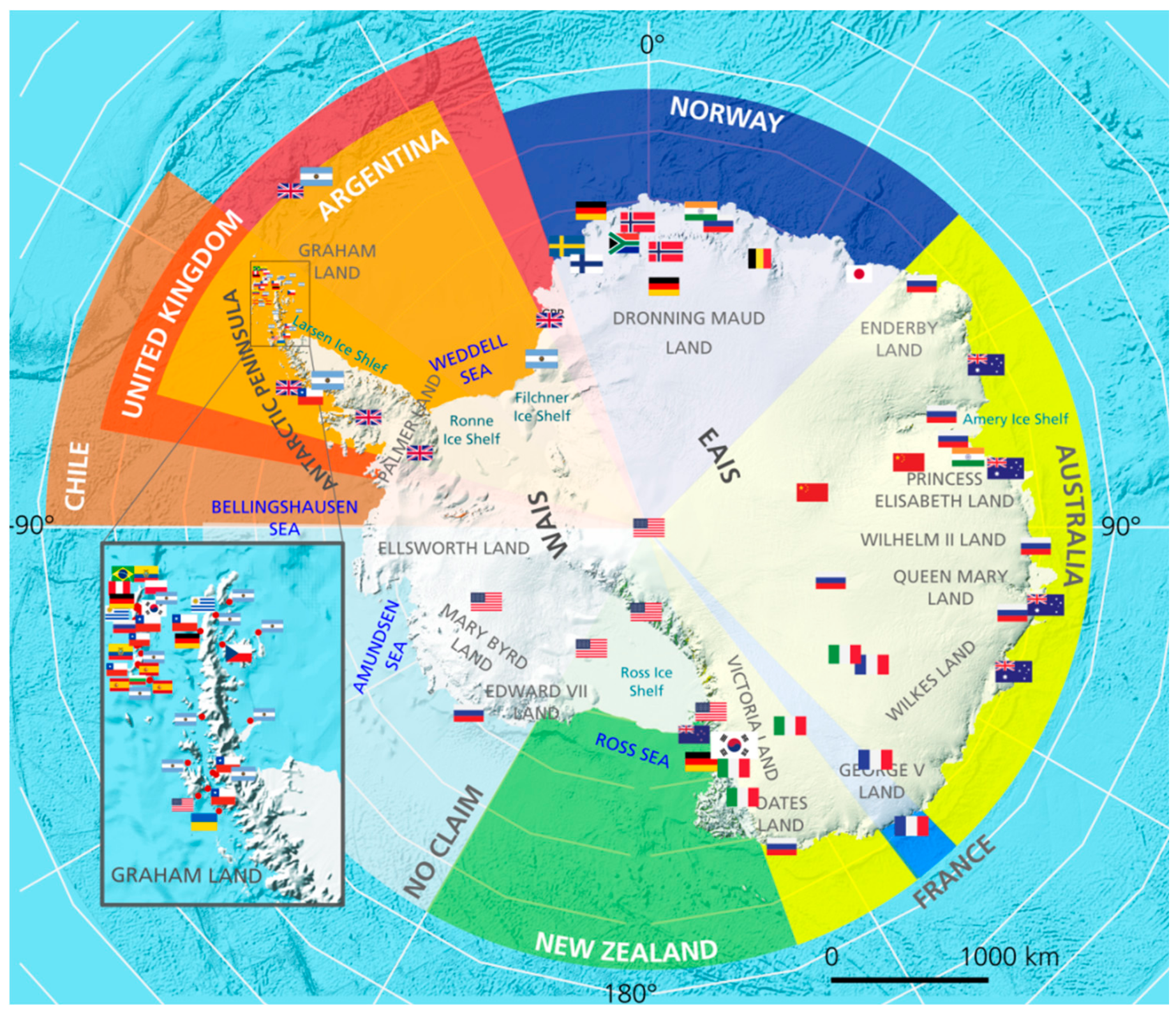
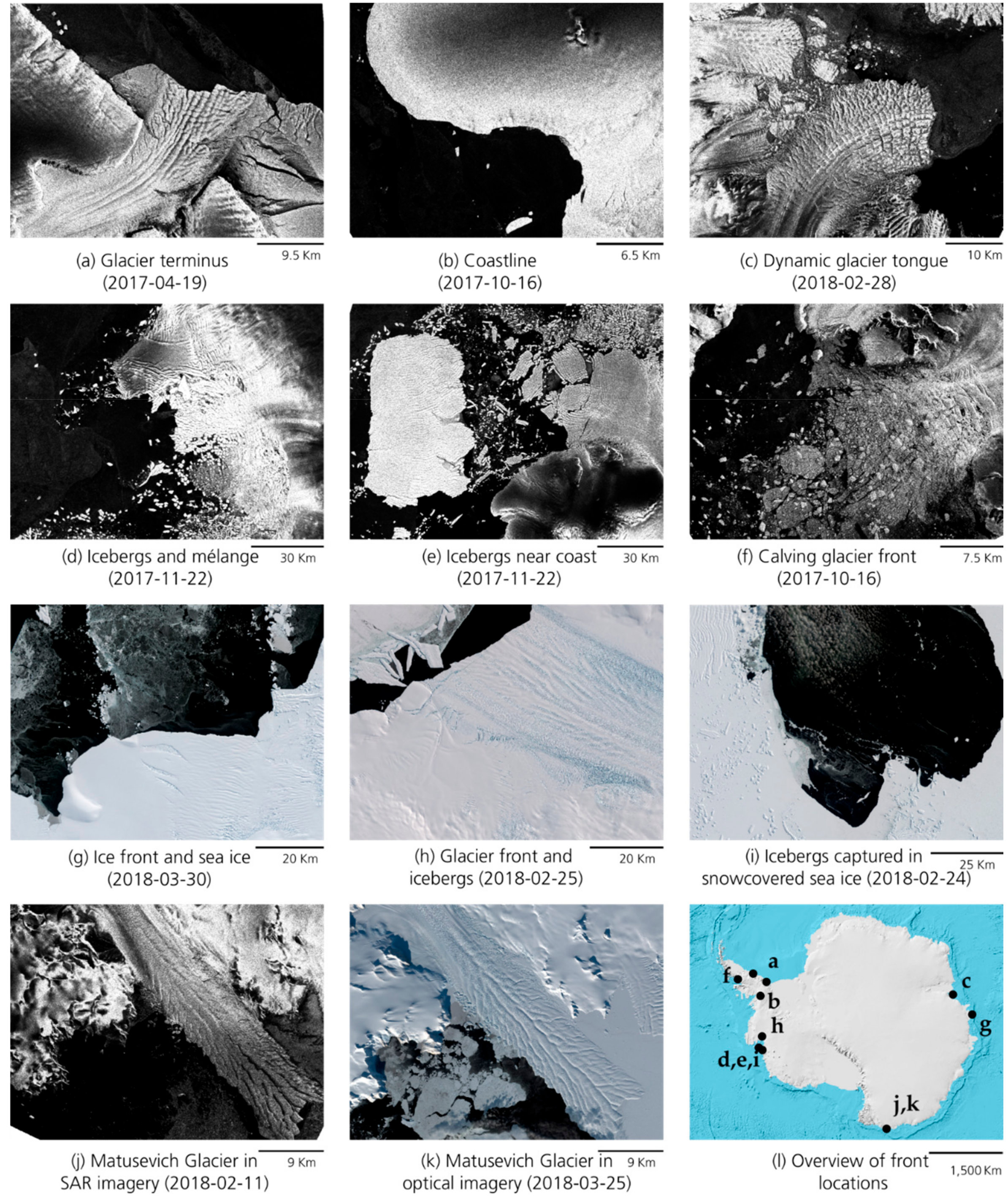
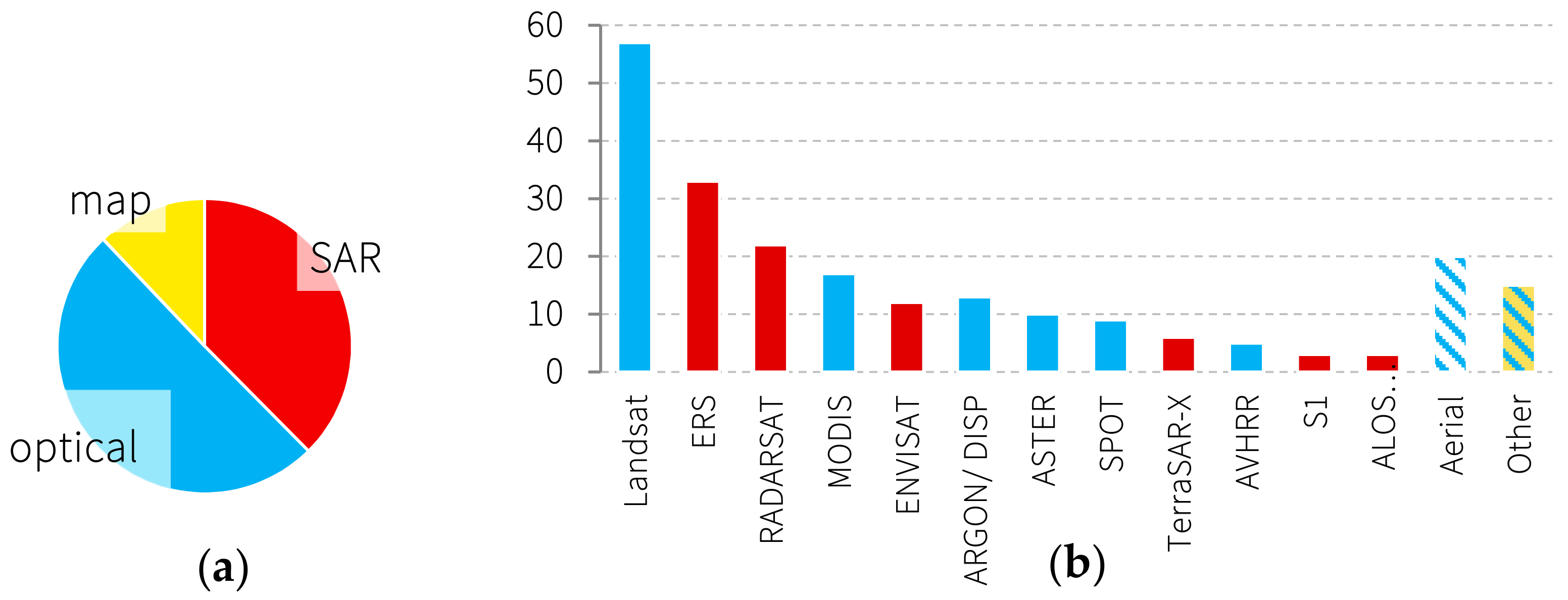

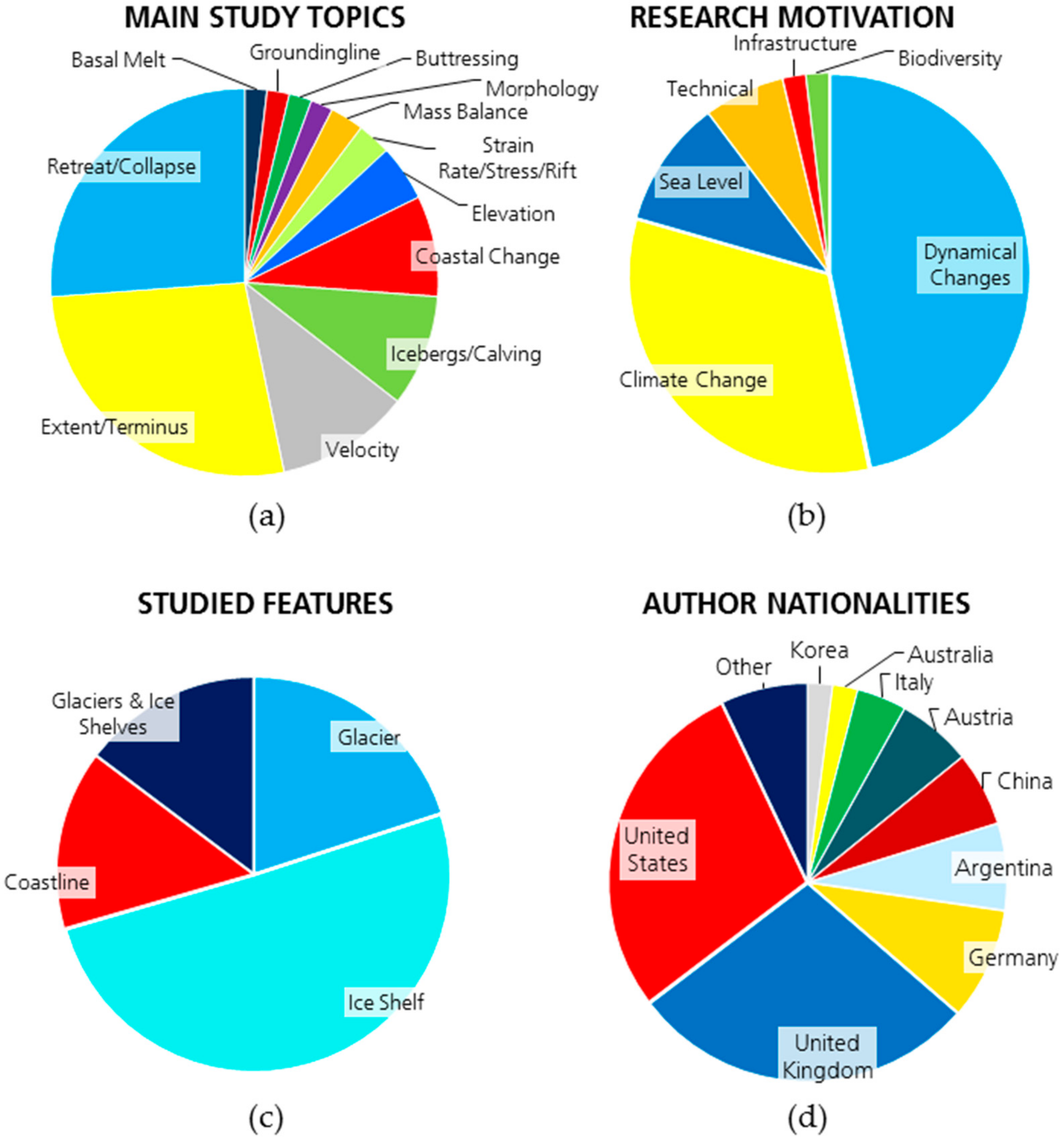
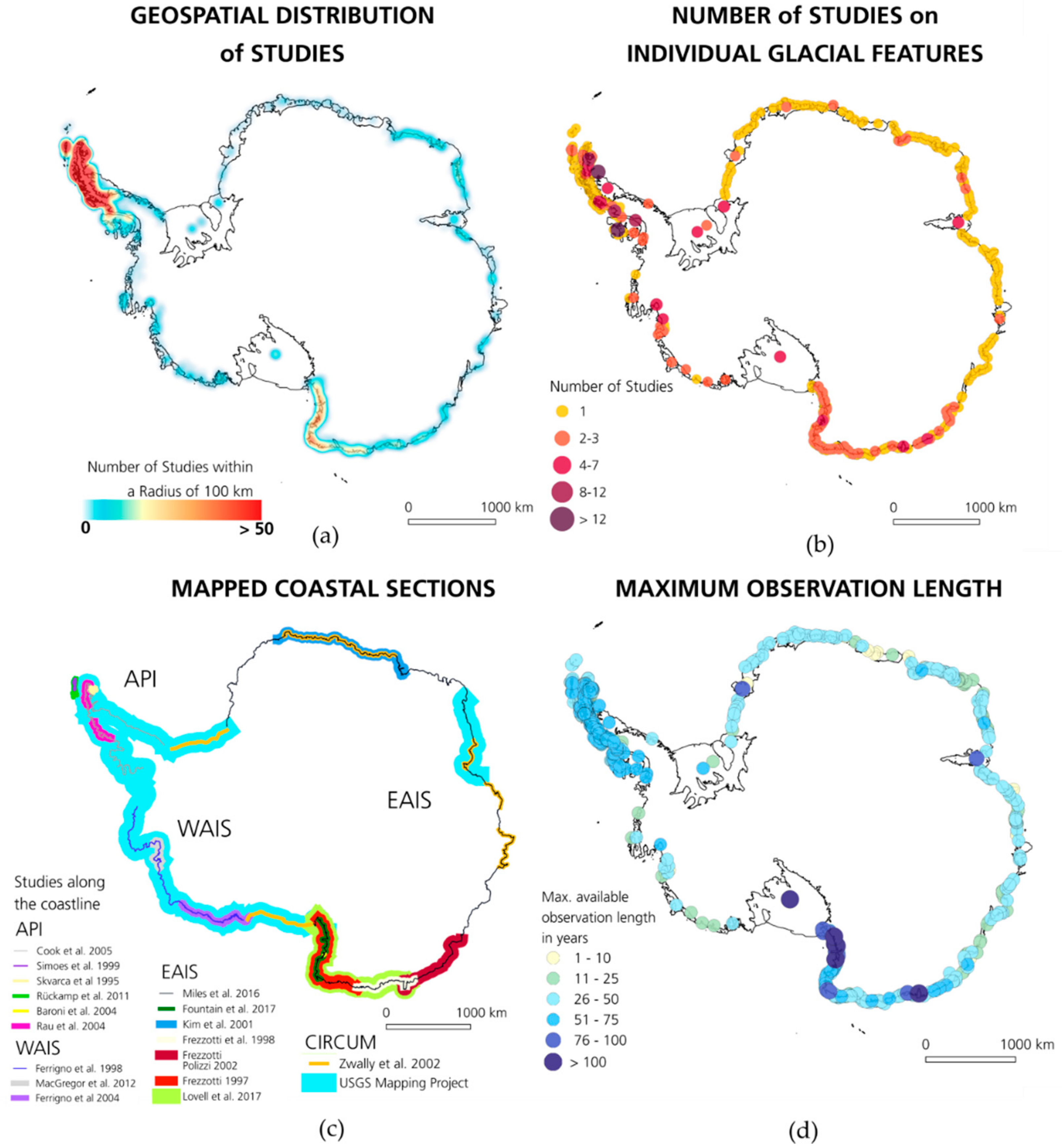
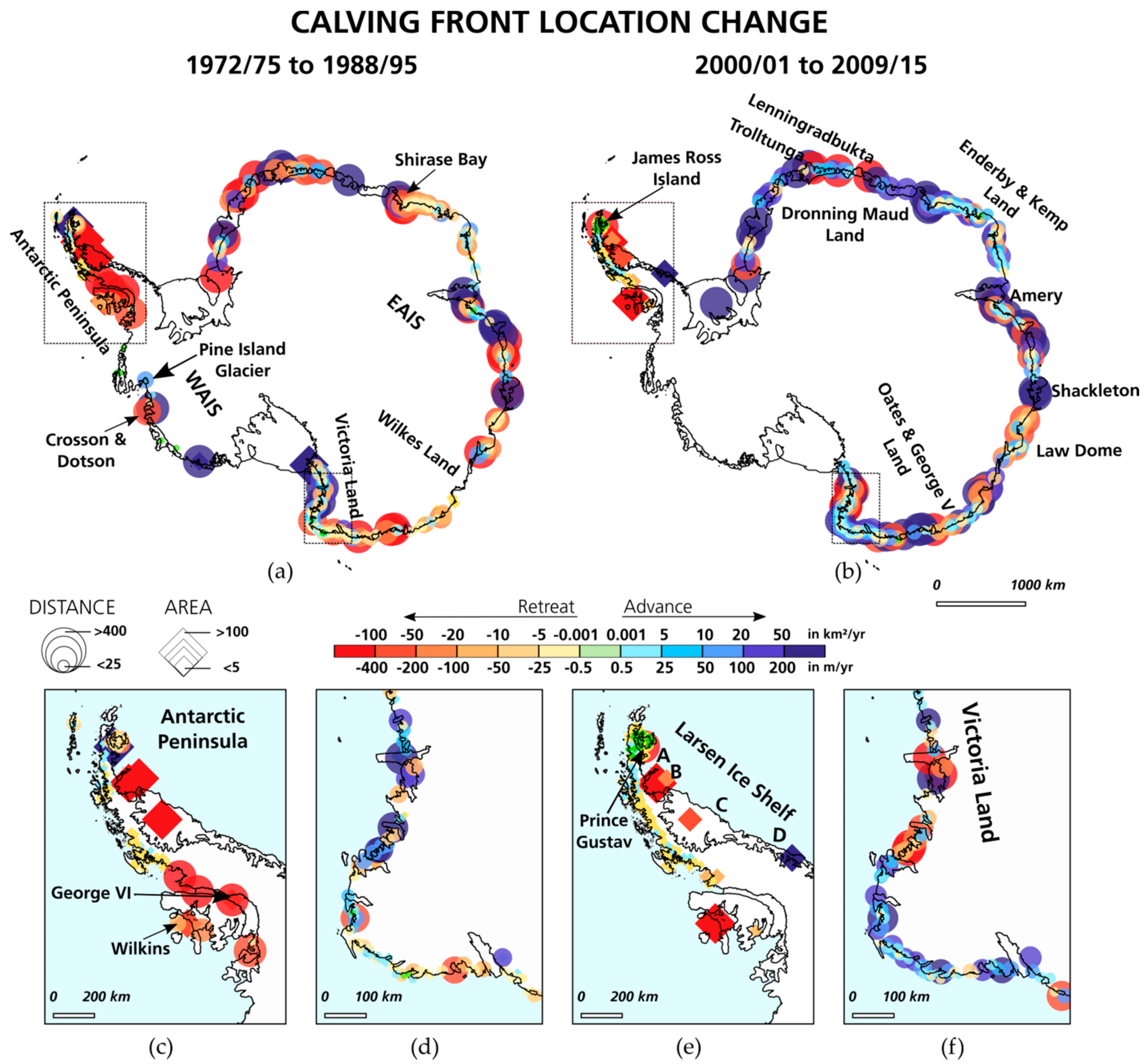
| Variable | Optical | SAR |
|---|---|---|
| Accuracy | High spatial accuracy and often higher resolution | Lower spatial accuracy |
| Data Availability | Low scene availability due to polar night and heavy cloud cover | High scene availability due to light independence and penetration of clouds |
| Snow and Clouds | Similar reflectance of snow and clouds for some wavelengths | Penetration of clouds and thin snow cover |
| Ice | Different spectral bands allow separation of ice features [67,68,69] Separation of shelf ice and fast ice sometimes challenging due to snow cover. | Change of backscatter values during the year (glacier facies) [58,63,70] Different ice types might have similar backscatter values |
| Additional | Even for non-experts, fronts are easy to distinguish | Wind roughening of the ocean surface [71]. High contrast for water–ice boundary [5]. Shadow, layover, incident angle, penetration depth |
| Manual | Semi-Automatic | Automatic | |
|---|---|---|---|
| Advantages | Applicable for every image type Quick for single glaciers Very accurate and precise Even “difficult” fronts can be mapped by experts | Less manual work Mapping large regions is possible | Quick, even for a large amount of scenes Monitoring possible |
| Disadvantages | Time-consuming Subjectivity of the observer Expert knowledge for difficult fronts necessary Not suitable for large-scale application | Manual post-processing still necessary Restricted to one sensor Expert knowledge for difficult fronts necessary | Not always accurate Long duration for algorithm development Only applicable for one sensor Computational cost is high |
| Study | A/SA | Based on | Image Processing Techniques | Test Area | Years and Amount of Data | Error | Difficulties |
|---|---|---|---|---|---|---|---|
| Sohn and Jezek 1999 [78] | A | ERS-1 | Edge enhancement Texture features Local thresholding Edge detection with Robert operator | 100 × 100 km 37.5 × 37.5 km Jakobshavn Glacier | 1988 + 19922 Scenes | 2–3 pixels 200 m | Lakes and outwash plains Sensor inaccuracies |
| SPOT | Thin snow | ||||||
| Seale et al. 2011 [54] | A | MODIS | Cloud masking Edge detection with Sobel operator + brightness gradient Removal of wrong data points via time-series | 32 glaciers 26802 fronts Greenland | 2000–2009 105,536 Scenes | 1.2% of data points wrong | Polar night and clouds Sensor inaccuracies Direction of scene |
| Klinger et al. 2011[65] | A | LIMA 1 Mosaic | Initial coastline + classification with nearest neighbor Three snake models with different parameters and edge detectors | 12% of Antarctic coastline | 1999–2003 | 6% of sections had to be corrected 12.1% false negative 13.7 false positive 1.5 pixel or 380 m | Initial coastline needed Sea ice to shelf ice boundary No greater change than 2 km allowed Manual post-processing necessary |
| Krieger and Floricioiu 2017[79] | A | TerraSAR-X Sentinel-1 | Canny edge detection Shortest path between edge candidates | Zachariae Isstroem | 2016 + 2017 2 Scenes | Mean distance between Expert and Automatic 246 m + 159 m | End and start point have to be specified for each glacier More diverse test areas are required |
| Liu and Jezek 2004 [5] | A | Landsat 7 | Pre-segmentation Segmentation Post-segmentation | 212 × 226 km | 1 Scene | One pixel (compared to visual interpretation) | Fast ice, sea ice, and wet snow Fixing errors in ArcGIS For optical imagery, perfect |
| RADARSAT | 409.6 × 409.6 km | 1 Scene | |||||
| Wu and Liu 2003[76] | SA | RADARSAT | Feature detection Wavelet transform Edge detection Texture for classification | Bering sea400 × 400 km | 2000 1 Scene | - | Also detects ice edge Parameterization Static thresholds No error calculation |
| Liu et al. 2015[27] | SA | ENVISAT ASAR | Object-based classification Watershed segmentation Manual modifications | Circum- Antarctic | 2005–2011 | Visually corrected | Manual work afterwards |
| Liu and Jezek 2004 [5] Liu et al. 2004[26] | SA | RADARSAT Mosaics AMM 2 and MAMM 3 | Lee filter for edge enhancement and speckle reduction Segmentation with local adaptive threshold Canny edge detector Manual editing and merging | Circum- Antractic | 1997 + 2000 Entire mosaic | 130 m (DEM) Visually corrected version available | Wind-roughened sea Sea ice Orthorectification |
| Miles et al. 2017[46] | SA | ENVISAT, ASAR | Pixel-based classification Polygon generation | Coastal Section | Monthly scenes 2002–2012 | 45% had to be manually corrected | Only 65% were automatically mapped precisely |
| Product | Provider | Year | Description | Access |
|---|---|---|---|---|
| ADD Coastline | ADD | 2002–present | Most up-to-date product. Parts of the coastline are frequently updated by various authors. Fronts are delineated from different remote sensing products. | www.add.scar.org |
| ADD Coastal Change | ADD | 1843–2008 | Front fluctuations for all glaciers on the Antarctic Peninsula. Based on the USGS mapping project [40]. | www.add.scar.org |
| Mosaic of Antarctica 2014 (MOA 2014) | NSIDC 1 | 2014 | Coastline manually delineated from MODIS mosaic 2014 [25]. | https://nsidc.org/data/nsidc-0730# |
| Mosaic of Antarctica 2009 (MOA 2009) | NSIDC 1 | 2009 | Coastline manually delineated from MODIS mosaic 2009 [25]. | http://nsidc.org/data/NSIDC-0593 |
| Mosaic of Antarctica 2004 (MOA 2004) | NSIDC 1 | 2004 | Coastline manually delineated from MODIS mosaic 2004 [25]. | http://nsidc.org/data/nsidc-0280# |
| RAMP AMM-1 (Antarctic Mapping Mission) | BPCRC 2 | 1997 | Coastline of RADARSAT Mosaic 1997[130]. | http://research.bpcrc.osu.edu/rsl/radarsat/data/ |
| RAMP MAMM (Modified Antarctic Mapping Mission) | BPCRC 2 | 2000 | Coastline of RADARSAT Mosaic 2000 [130]. | http://research.bpcrc.osu.edu/rsl/radarsat/data/ |
| Antarctic Boundaries MEaSURE V2 | NSIDC 1 | 2008–2009 | Coastline extracted from ALOS PALSAR and ENVISAT ASAR during the International Polar Year (IPY). | http://nsidc.org/data/NSIDC-0709 |
| Coastal Change and Glaciological Maps of Antarctica | USGS | 1843–2009 | Maps with different front positions mainly AP and WAIS. | https://pubs.usgs.gov/imap/2600/ |
| ESA CCI3 | ENVEO4 | planned | Displaying front positions for specific glaciers (so far Antarctic Peninsula) | http://cryoportal.enveo.at/iv/calvingfront/ |
© 2018 by the authors. Licensee MDPI, Basel, Switzerland. This article is an open access article distributed under the terms and conditions of the Creative Commons Attribution (CC BY) license (http://creativecommons.org/licenses/by/4.0/).
Share and Cite
Baumhoer, C.A.; Dietz, A.J.; Dech, S.; Kuenzer, C. Remote Sensing of Antarctic Glacier and Ice-Shelf Front Dynamics—A Review. Remote Sens. 2018, 10, 1445. https://doi.org/10.3390/rs10091445
Baumhoer CA, Dietz AJ, Dech S, Kuenzer C. Remote Sensing of Antarctic Glacier and Ice-Shelf Front Dynamics—A Review. Remote Sensing. 2018; 10(9):1445. https://doi.org/10.3390/rs10091445
Chicago/Turabian StyleBaumhoer, Celia A., Andreas J. Dietz, Stefan Dech, and Claudia Kuenzer. 2018. "Remote Sensing of Antarctic Glacier and Ice-Shelf Front Dynamics—A Review" Remote Sensing 10, no. 9: 1445. https://doi.org/10.3390/rs10091445
APA StyleBaumhoer, C. A., Dietz, A. J., Dech, S., & Kuenzer, C. (2018). Remote Sensing of Antarctic Glacier and Ice-Shelf Front Dynamics—A Review. Remote Sensing, 10(9), 1445. https://doi.org/10.3390/rs10091445





